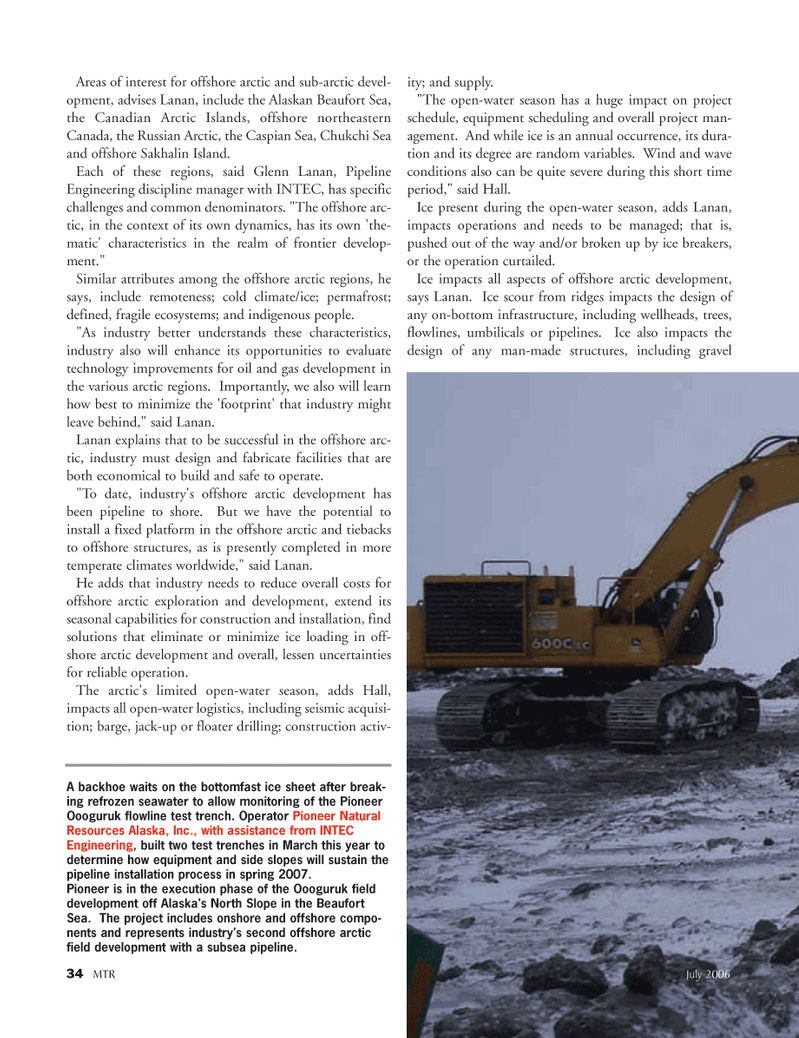
Page 34: of Marine Technology Magazine (July 2006)
Underwater Defense: Port & Harbor Security
Read this page in Pdf, Flash or Html5 edition of July 2006 Marine Technology Magazine
Areas of interest for offshore arctic and sub-arctic devel- opment, advises Lanan, include the Alaskan Beaufort Sea, the Canadian Arctic Islands, offshore northeastern
Canada, the Russian Arctic, the Caspian Sea, Chukchi Sea and offshore Sakhalin Island.
Each of these regions, said Glenn Lanan, Pipeline
Engineering discipline manager with INTEC, has specific challenges and common denominators. "The offshore arc- tic, in the context of its own dynamics, has its own 'the- matic' characteristics in the realm of frontier develop- ment."
Similar attributes among the offshore arctic regions, he says, include remoteness; cold climate/ice; permafrost; defined, fragile ecosystems; and indigenous people. "As industry better understands these characteristics, industry also will enhance its opportunities to evaluate technology improvements for oil and gas development in the various arctic regions. Importantly, we also will learn how best to minimize the 'footprint' that industry might leave behind," said Lanan.
Lanan explains that to be successful in the offshore arc- tic, industry must design and fabricate facilities that are both economical to build and safe to operate. "To date, industry's offshore arctic development has been pipeline to shore. But we have the potential to install a fixed platform in the offshore arctic and tiebacks to offshore structures, as is presently completed in more temperate climates worldwide," said Lanan.
He adds that industry needs to reduce overall costs for offshore arctic exploration and development, extend its seasonal capabilities for construction and installation, find solutions that eliminate or minimize ice loading in off- shore arctic development and overall, lessen uncertainties for reliable operation.
The arctic's limited open-water season, adds Hall, impacts all open-water logistics, including seismic acquisi- tion; barge, jack-up or floater drilling; construction activ- ity; and supply. "The open-water season has a huge impact on project schedule, equipment scheduling and overall project man- agement. And while ice is an annual occurrence, its dura- tion and its degree are random variables. Wind and wave conditions also can be quite severe during this short time period," said Hall.
Ice present during the open-water season, adds Lanan, impacts operations and needs to be managed; that is, pushed out of the way and/or broken up by ice breakers, or the operation curtailed.
Ice impacts all aspects of offshore arctic development, says Lanan. Ice scour from ridges impacts the design of any on-bottom infrastructure, including wellheads, trees, flowlines, umbilicals or pipelines. Ice also impacts the design of any man-made structures, including gravel
A backhoe waits on the bottomfast ice sheet after break- ing refrozen seawater to allow monitoring of the Pioneer
Oooguruk flowline test trench. Operator Pioneer Natural
Resources Alaska, Inc., with assistance from INTEC
Engineering, built two test trenches in March this year to determine how equipment and side slopes will sustain the pipeline installation process in spring 2007.
Pioneer is in the execution phase of the Oooguruk field development off Alaska's North Slope in the Beaufort
Sea. The project includes onshore and offshore compo- nents and represents industry's second offshore arctic field development with a subsea pipeline. 34 MTR July 2006
MTR#6 (33-48).qxd 7/11/2006 9:06 AM Page 34

 33
33

 35
35
